Protect and Organize Your COVID Vaccination Card
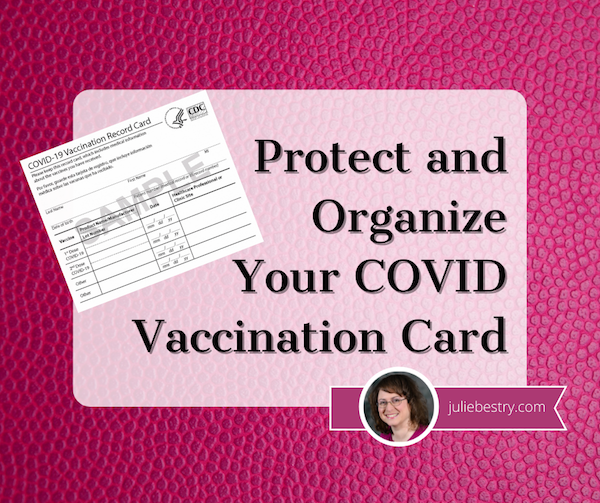
Throughout 2021, I’ve received a lot of questions from clients and readers regarding the best way to protect COVID vaccination cards from damage and where to store them for easy access.
WHY KEEPING YOUR VACCINATION CARD SAFE AND ACCESSIBLE IS ESSENTIAL
Let’s start at the beginning, even before COVID. While there’s been a great deal of hubbub lately about having to prove one’s vaccination status for work or to go various places, any adult knows that there have always been a variety of reasons one has had to prove they’ve had proper vaccinations.
Have you ever registered a child to attend school? Vaccination requirements date back to the mid-19th-century, when states began requiring proof of immunization against smallpox in order to register for school. Dating back at least as far as the WWII era, American schools have required proof of immunization against other communicable diseases. And while each state generally has its own laws regarding exactly what shots must be administered (and what medical or other exemptions exist), there are commonalities across all states.

For their children to attend kindergarten, parents usually have to provide documentation from physicians that their children have received the following immunizations:
- Diphtheria-Tetanus-Pertussis (DTaP, or DT if appropriate) — required in all 50 states
- Haemophilus influenzae type B (Hib)
- Hepatitis A
- Hepatitis B (HBV) — required in 43 states
- Measles, Mumps, Rubella — required in all 50 states
- Pneumococcal conjugate vaccine (PCV)
- Poliomyelitis (IPV or OPV) — required in all 50 states
- Varicella — required in all 50 states
(Note: Paper Doll is not a medical practitioner. Speak with your physician(s) regarding the requisite inoculations in your state appropriate for your family members. The CDC has a printable immunization schedule for your reference.)
To attend college, students have to prove they’ve been inoculated against a variety of contagious diseases. Students born before 1957 don’t have to have the MMR because, back then, measles, mumps, and rubella existed as separate shots. Students born before 1980 were generally never inoculated for varicella (that’s chicken pox to you and me) because the immunization for that horrible, itchy, scarring, illness (which can cause painful shingles later in life) didn’t exist yet.
In general, college students have to get the Meningococcal B immunization. (Take meningitis seriously; I know a guy who had meningitis in college, and he lost hearing in one ear.) College students are also advised to be get the vaccinations for HPV and the flu.
Summer camps and extra-curricular athletic programs generally require the same proof of vaccinations as elementary and high schools do, for both employees and campers/participants, with the addition of tetanus boosters. As an aside, we’re all supposed to get tetanus boosters every 10 years. (Considering most of us keep thinking 1980 was just 20 years ago, please check with your physician regarding the last time you actually had a tetanus booster.)
Certain jobs or professions require vaccinations. Obviously, there are requirements (by state) for healthcare workers. Because different illnesses can be airborne, water-borne, or spread by wounds or bodily fluids (OK, let’s all pause to say “Ick!”), hospitality and restaurant workers often have to prove that they’ve received their inoculations for Hepatitis A and B, the flu, and tetanus/diptheria/pertussis. Again, states vary, but teachers are generally required and/or advised to receive all of the same inoculations as students in kindergarten through college.
Vaccinations are required for travel to and from the United States (and many other countries). For travel just about anywhere, you should be sure to be have your DPT, MMR, polio, varicella, and flu shots, but for travel to many nations, you may need to get vaccinated against cholera, malaria, hepatitis A and B, typhoid, rabies, and/or yellow fever. (The CDC has nation-by-nation pages.)
 Photo by Tmaximumge from PxHere
Photo by Tmaximumge from PxHere
And, of course, there’s COVID. The longer part of the population goes unvaccinated, the more opportunity the Delta, Delta+, Lambda, and other variants have to mutate, evolve, grow, and become more dangerous. So, every day, more schools, employers, governments, and nations are requiring COVID vaccinations, and thus, proof of vaccinations.
For the variety of reasons explained above, you may need to prove you’ve been vaccinated against contagious illnesses. If you are unable to do so, you (or a member of your family) may not be able to attend school, get a certain job, or avail yourself of a variety of travel or entertainment options. In some cases, you can get inoculated again for certain diseases; for others, that’s not possible.
If your pediatrician is still in practice, you may be able to get copies of your records. Paper Doll was delivered by a physician born in 1894 and my pediatricians have all long since retired. But because Paper Mommy was diligent in maintaining family medical records and passing them along, it was easy for me to handle my own information when registering for college and graduate school and for verifying immunizations later in life.
For others, though, lack of organized systems for maintaining medical information presents a problem, which is why this blog has had so many posts over the years regarding organizing medical records and why it will continue to do so.
HOW & WHERE SHOULD YOU KEEP YOUR COVID VACCINATION CARD?
Can you keep your vaccination card in your wallet? Obviously, yes.
But should you keep your vaccination card in your wallet? That’s a more complicated question. Here’s what I suggest you do.
1) Take a photo of your COVID vaccination card. (But no, don’t post it to social media. Your birth date and other personal information on your card is fodder for identity thieves, so don’t post it, or your driver’s license or other ID, on “the socials.”)
Take a photo of your COVID vaccination card. (But no, don't post it to social media. Your birth date and other personal information on your card is fodder for identity thieves, so don't post it, or your driver's license or other ID,… Share on XLabel the photo with your name (or your family member’s name, if you’re keeping records for your spouse, kids, or parents) and date. Something like:
COVIDVax-BenedictCumberbatch-April2021
Once you have your photo or scanned copy, don’t just count on it living in your camera roll. Save it to one or more of the cloud solutions you use often, whether that’s Dropbox, Evernote, OneNote, iCloud, GoogleDrive, or something similar.
Create a folder for Vital Documents or VIPs (very important papers), and you can gather all of your other photos/scans of essential documents, from your birth certificate to other vaccination records, all in one logical place.
2) Think about your lifestyle and how often you will be needing to show your vaccination card. If you are a frequent traveler, you’ll need to show your card often, and may want to keep it in your wallet or purse. If, however, you are working remotely and live somewhere that proof of vaccination hasn’t (and isn’t likely to) come up with frequency because you’re avoiding crowded, indoor spaces, you can file it away.
This is a good time to get aware of the rules of where you live and where you’re going. For example, New York City announced last week that COVID vaccines will be required for anyone wishing to enter restaurants, bars, or gyms; in California, they’re weighing the same types of requirements for using indoor amenities.
In France, the law requires that anyone wanting to go to a bar or restaurant must have proof of COVID vaccination. As of this past weekend, in Italy, you’ll need your proof of vaccination to gain access to indoor seated dining at restaurants and bars, museums, exhibitions, cultural sites, sporting events, swimming pools, gyms, concerts, fairs, conferences, amusement parks and other venues.
3) File your card away if you’re not going to need to carry it around. For many people, the most logical place to file your proof of COVID vaccination will be in your family filing system, in your personal medical file. That might be in a regular file drawer, or in something like the Smead All-in-One Healthcare & Wellness Organizer.
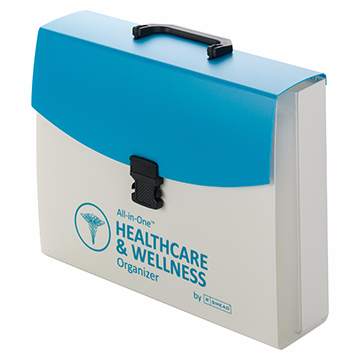
However, if your file is bulky even after you’ve pared it down to your actual medical records, you may want to store your vaccine card with your other VIPs (very important papers), like your birth certificate and Social Security Card, in your fireproof safe, for quick and easy access.
IN WHAT SHOULD YOU KEEP YOUR VACCINATION CARD?
The best way to protect your vaccination card is to find a clear, flat, snug container. At the most basic, you can grab any zipper-lock sandwich bag, which protect your card from moisture, germs, and general schmutz. However, you won’t get a great fit.
The official CDC COVID vaccination card is 4″ wide by 3″ high. A typical zipper-lock sandwich bag rang from 6 1/2″ x 5 7/8″ to 8″ x 5″, yielding a lot of extra space. The half-height snack bags are 6 1/2″ wide x 3 1/4″ high, which offers a slightly better fit, but still with wiggle room, so you’ll either have unused space or be tempted to fold the bag over onto itself.
If you’re going to be keeping your vaccine passport card in a manila folder or three-ring binder, amid your other personal or family records, a plastic sheet protector will generally do the trick. However, sheet protectors are open at the top end, so if you’re going to be carrying your records around (say, if you’re a college student moving at the end of each semester or school year), it’s not a perfect solution.
You might have an old badge holder around the house, if you’ve ever attended a conference or had a job that required an ID to get into the building. I dug through some old NAPO conference paraphernalia and found this badge—but only for photographic purposes.

The clear plastic badge holder seems almost ideal and it comes with a lanyard for wearing around one’s neck, which keeps hands free and prevents accidental loss. However, aside from the fact that the ribbons are permanently affixed and the sticker on the front isn’t going anywhere without making a gummy mess, the top of the badge holder is open. Without a snug fit, a vaccine card could fall out and get lost.
Personally, I’m more inclined to recommend one of the following inexpensive solutions. I started by searching Amazon and found a wide variety of basic options.
Clear vinyl plastic sleeves made to accommodate the CDC cards fit all the requirements. I believe no particular brand is better than any other, but as an example, Amazon carries Mljsh (yes, really, no vowels) CDC Vaccination Card record holders.
The sleeve is waterproof and has a re-sealable zipper. The inner dimensions are 4.31″ wide x 3.11″ high to accommodate a laminated card. A package of two costs $5.28.
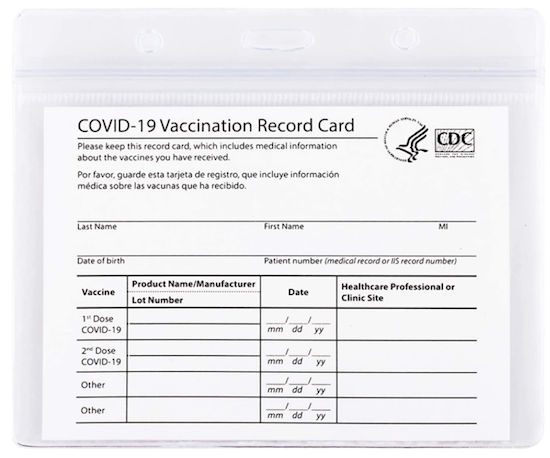
What I like about this particular card is that at the top, there are three slots/punctures so that you can attach your sleeved vaccine card to a lanyard or one of those retractable badge holders, the kind that makes that satisfying zip-line sound when retracting — Zzzzzwwwwjjjjzzzzz!
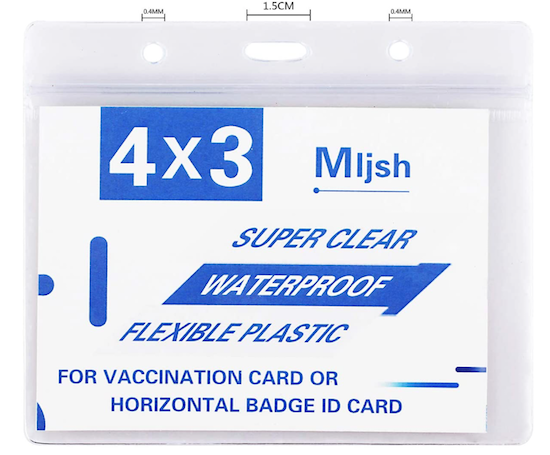
Again, Paper Doll is brand-agnostic regarding what card holder you choose, but I do like the fact that this one has both the plastic zipper top and the punched holes for accommodating a lanyard. However, there are so many options that it would be hard to select a wrong card holder.
If you need color in every area of your life, instead of picking a clear vinyl solution, you could choose something like Gurcyter’s more colorful design.
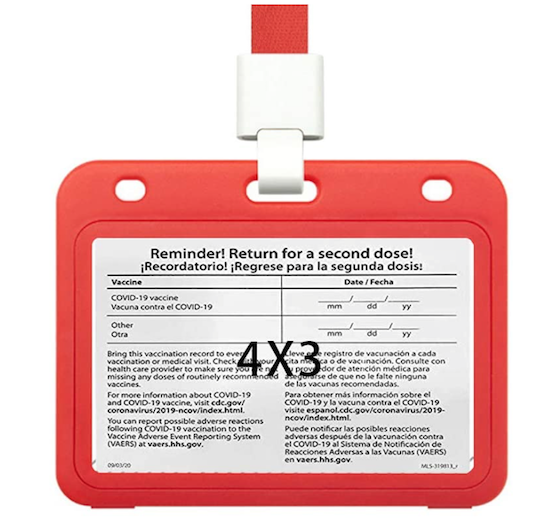
The front and back split open to allow you to center your vaccine card, and you get to choose from among five colors (red, dark blue, light blue, green, or yellow), and it comes with a matching 18.1″ ribbon lanyard.

One holder is $6.99. Note, however, that the Gurcyter version is a little bit squished vertically, with the interior of the holder measuring 4.13″ wide x 2.91″ high, wide enough for a standard CDC card, but .09″ (2.2mm) shorter. So, if you pick this option, you might need to trim a little white space on one or both sides. (The things people will do for fashion!)
If you’re doing a lot of traveling, you might want a combination passport and vaccine card carrier. There are a number of colorful combination holders, like this Ciana faux leather, bi-fold passport and vaccine card holder for $5.99.
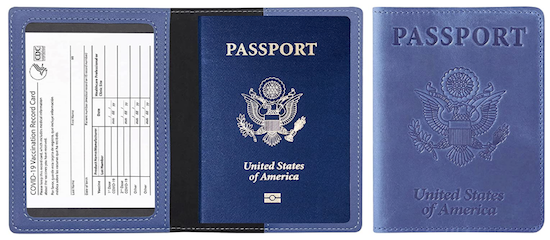
It comes in twelve colors (brown, burgundy, carbon-fiber black, dark blue, green, grey, light blue, pink, purple, red, rose gold, and turquoise), with a see-through compartment for your vaccine card and a sleeve for your passport.
Of course, Amazon isn’t the only place to find these solutions. A quick search of “vaccine card holder” or “vaccine card protector” will yield a number of options. As with masks, which are utilitarian but became fashion statements over the past 18 months, the creative people at Etsy have come up with solutions for every taste and style.
If you’d like to aim for a classier vaccine card holder, the Familiar Paws Etsy shop has leather vaccine card holders with a key ring for $12.99.
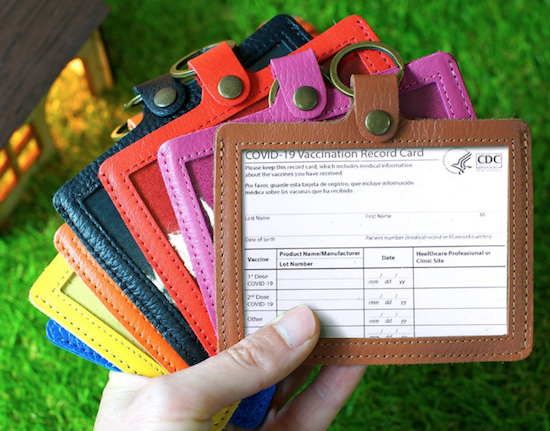
The front of the vaccine card is visible through the clear plastic window, and you can select from among a variety of soft, full-grain genuine leather options in one of eight colors (orange, navy blue, brown, pink, black, red, yellow, and aquamarine). At the top, the leather tab folds over a key ring. (Familiar Paws offers personalization with names or initials for an additional cost.)
For something cozier, Etsy shop QueentopazCreations uses Rifle Paper Company fabrics to create cloth vaccine card wallets.
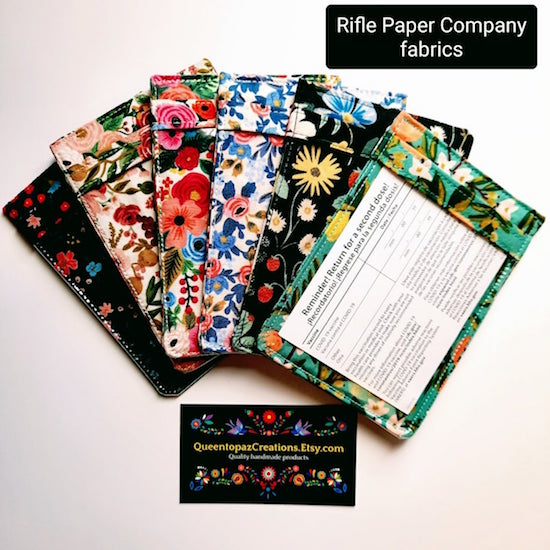
The card wallets come in six fabric designs (Strawberry Fields, Garden Party, Wildwood, Garden Party/Rose, Rosa Periwinkle, Citrus Floral Teal, and Herb Garden) and in two sizes: 4″ wide by 3″ high, for $13, or 4 1/4″ wide by 3 1/2″ high, for $15.
Each cloth wallet sleeve has stiff interfacing and a plastic insert to protect your card from bending. My only concern is that absent a zipper-lock mechanism, you’d want to make sure your card fits snugly in the wallet and won’t fall out.
Etsy also has some splashy and fun (if sometimes potty-mouthed) vinyl vaccine card holders, and more than a few options that say, “Proof of Fauci Ouchie!”
I’d be hard-pressed to encourage any client to spend more than $15 for something to hold a vaccine card, but if you’re the sort of person who buys $300+ shoes and can turn anything into a status symbol, Fashionista.com has a piece on vaccine passport cases and lanyards for keeping your cards fashionably handy (for ridiculous-to-me prices of $100-$500)!
TO LAMINATE OR NOT TO LAMINATE?
When the vaccine first became available, social media buzzed with suggestions for laminating COVID vaccination cards. It’s easy to understand why; paper is easily torn or damaged if it gets wet, and laminating paper protects it from both. However, there are some concerns with laminating your COVID vaccine card.
First, it’s becoming increasingly clear that booster shots may become necessary. If so, we may need to present our original vaccine cards to have more information added to the two lower lines where “other” is printed. Laminating the vaccine cards would prevent new information from being added; the vaccine site would probably end up having to give you a new card, which would obviate going to so much effort to protect your current one.
Second, if done incorrectly, laminating plastics and adhesives can damage your card. So, if you’ve got a laminator but haven’t ever cracked open the box, maybe starting with a vital document isn’t the best notion? Big box stores like Staples and Office Depot have offered to laminate vaccine cards for free, but obviously that’s designed to tempt you into the store to shop.
WHAT IF YOU LOSE YOUR VACCINATION CARD?
The federal government is not keeping a master list of who has been vaccinated, but the individual states are. So, if you lose your vaccination card, don’t panic! Each state has its own computerized vaccination registry. Just contact your state’s department of health to request a replacement; you will likely have to provide some personal information and request the documentation in writing or through the state’s website.
The CDC has a list of contacts for the immunization information systems (IIS) in each state. Not only can you request replacement cards through your state’s system, but you can get copies of your child’s immunization records for all the purposes described earlier in this post.
If you got your vaccination at a national pharmacy chain, you can contact them directly. For example, if you were vaccinated at Walgreens or CVS, the pharmacy chains can check their internal records and replace your card. Also, for most such retail pharmacy chains, you are able to create an account online and access your COVID-19 vaccination records directly.
Meanwhile, because the first thing I told you to do, up above, was photograph your card, you do have some level of proof of which vaccine you received and when.
FINAL NOTE
Nothing in this post should be considered controversial. We live in a society that has rules. “No shoes. No shirt. No service.” We have to wear seat belts and carry car insurance. Income tax filings are due (generally) on April 15th. And historically, to promote the general welfare and safety of students, campers, employees, customers, and citizens, rules are put in place by schools, camps, businesses, and governments.
Just as we have to show that we have a valid driver’s license to operate a motor vehicle or a passport (and visa) to enter a foreign country (or return to our own), there are times that we have to prove that we have been inoculated, whether it’s against polio and smallpox, or against COVID. Today’s post, like many others I’ve written, simply ensures that you know the best ways to protect and organize your vital documents.
I hope you will do all that’s necessary to stay safe, healthy, and organized.




excellent blog and important information!! I have my card in a protective clear pocket! I have already had to show it at certain functions.
Thanks for this great blog!
Thanks for the kind words, Lisa, and for reading!
What great information! I keep my family’s vaccination cards in our lockbox with passports, etc. I have a virtual copy of the cards in google photos in an album marked “Vaccination cards.” I also sent copies to our doctors so they have it in their records.
It sounds like you’ve got it all covered, Jill! I wouldn’t have thought to send a copy to your physicians, but that’s an excellent idea. Thanks for reading and commenting.
Ahhh. The storing of the vaccination card and how to best do that. My first thought was to laminate it, but as you mentioned, if a booster is needed (which is likely,) the lamination will be a hindrance to updating the info. At this point, I have it stored several ways- it’s folded (unprotected) in my wallet, I have a photo of it on my phone (which is backed up in the cloud,) and I have an app that NY state has, which allows you to upload your card, which has been validated by the vaccination provider. You can show the e-version to venues requiring proof. I’m tempted to get one of the fun cases you showed, but for now, I think I’m all set.
Lastly, the place where I was vaccinated told me that if I ever lost my card, they could easily issue me a new one. So if the above three things fail, I have that option too.
Linda, how funny that it never occurred to me to fold the card. Somehow, “Do not fold, spindle, or mutilate” is in my head whenever I get a document on card stock! I wish all states had the app New York has made, which is closer to what is being done in almost all other nations. (We’re just the only country with only flimsy paper cards, as if it were 1921 instead of 2021!) And that’s great that your card can be replaced so easily at the original location; here, the Health Department set up three pop-up locations where most people got vaccinated, and two of those locations don’t exist now.
I like the idea of keeping the original in a clear plastic sleeve. I have them in a fireproof safe in a folder marked important documents. It’s nothing fancy, but it works.
I’m all about “nothing fancy,” as that’s my style, too! Thanks for reading, Sabrina!
Well this sure is timely! NYC has announced they will start requiring proof for all restaurants, bars, entertainment venues, etc. I’ve had mine in my wallet, but I don’t always want to lug my big wallet around. Might have to get these for all of the family members. Thanks so much for this post!
As I wrote about New York City, California, France, and Italy, I briefly thought that all the places I want to visit (again) are requiring this proof for more behaviors. (Ah, Italy!) I never leave my house without my whole purse, wallet included, but if I had a travel-light lifestyle, a small cardholder for the vaccination card and wallet would be great. Thanks for reading!
Excellent! Julie, I can always count on you to do the absolute best research! These are such great options. I like the one that has the ring at the top. I have been carrying mine around in my wallet. I have not yet (I know, I will today – promise) taken a picture of my vaccination card.
Hee, I will ask you on the next NAPO-GA call, Diane, if you’ve taken the photo yet! 😉 Thank you so much for your kind words!
Your suggested file name for the photo of the card — ha ha ha! So far I have opted for snack bag protection and found a perfectly sized, secure pocket in my purse. But if places are going to accept photos of cards as proof, maybe I’ll leave the original at home.
Well, I’m sure Benedict is vaccinated, and he spends so much time in the US, he may have a CDC vax card, so I want to make sure he knows what to do!
The snack bag works fine if you don’t also want to put it in your wallet. Zipper-lock bags fold badly. But I wish we’d get a national registry, or at least statewide registries with digital proof, so we could just flash our phones.
I wanted to frame mine and hang it on the wall…but I settled for a PDF on my Scanner Pro app and then secured it in my fire safe. I really hope that my kiddos’ pediatrician will start tracking COVID shots like they track all the other required vaccinations for school. Thanks for this post.
I like your inclination as well as your eventual decision. (But you know I’ll never get around to framing and putting anything up on my walls!) Jill Katz, up above, said she sent copies to all of her family’s doctors, so maybe if you send it to the pediatrician’s office, they’ll log it!
I love that you are the Bible of who, what and information. I do have my original card with several other documents in a safe place. I also have a copy on my phone ( in a folder ) and everything on my phone is backed up.
I didn’t know about the protective sleeves but now I do and I’m going to get one for every member of my family. So thank you for that!
I too like Jill’s smart tip about sending a copy of the card to her doctor. It’s another great way to secure the information.
Thanks for the flattery. I’ve never considered myself as biblical! 😉
I like the card holders, but am hoping that it never comes to the point that we have to carry our cards all the time.
I know what you mean, Janet. Part of me thinks they’re nifty (because I love things with a specific purpose), part of me wants this all to go away so we won’t need the reminders of illness and treatment and prevention, and part of me wants magic force fields erected to keep everyone safe and likes to think of the cards as a metaphorical force field.
Colorado has a vaccination registry -(https://ciis.state.co.us/public/Application/PublicPortal – and so my doctors already knew I was vaccinated even though I went out of practice to get it done. Remember when it was impossible to schedule? Hard to believe now. I also have a photograph of my card in my phone and the original is going to be sitting by my side as we make our choice from the excellent options you’ve provided here. Some sixth sense stopped me laminating it and now I’m relieved!
Lucy, you’re so lucky that you live someplace that is so organized and modernized. As for the other part, now that I’ve written this post, I feel like Big Lamination is going to be out to get me. 😉
A question you might be able to address, about making durable wallet-sized cards to carry around: https://ask.metafilter.com/356647/How-can-I-get-a-color-copy-of-my-vaccine-card-printed-on-a-wallet-card
Thanks for thinking of me, Sumana; usually it’s Jessamyn or Cortex tweeting me to say, “Hey, there’s an organizing question for you!”
By the time I saw your comment, CrystalDave had replied with the VaxCard solution for getting the original poster a non-official, colorful laminated card for those times the OP just wants to go to bars and restaurants and has to hand over an actual card. VaxCard is definitely an interesting solution; I’d probably have recommended a DIY approach (scanning, printing, then using that copy in one of the solutions I described in this post), so that’s a great perspective.
Great overview!
I also got a QR code record of my vaccination that I was able to add to my iPhone wallet. It’s a verification through GoGetVax.com (https://www.gogetvax.com/)
Wow, Connie, that four-level validation is impressive! Thank you for sharing.